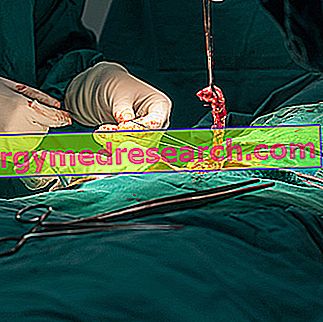Generality
The appendectomy is a surgical procedure that involves the removal of the appendix. This type of operation is usually performed in case of appendicitis, acute or chronic.

Appendicitis: definition and causes
Appendicitis is an inflammatory disease that occurs in the appendix.
The appendix - also defined as " vermiform appendix " - is an extension that starts from the initial tract of the large intestine.
Appendicitis is usually caused by an obstruction of the appendix itself. This obstruction, in turn, can be caused substantially by:
- Stagnation of undigested material (fecaloma);
- Hypertrophy of appendicular lymphatic follicles, which tend to increase in volume and number, especially in case of local or systemic infections.
Unfortunately, there is no type of drug therapy that can cure appendicitis definitively; therefore, the only resolutive treatment consists in the surgical removal of the appendix, then in the appendectomy.

In any case, timely treatment of appendicitis is essential, as this can be complicated, causing the appendix to rupture and giving rise to abscesses and peritonitis.
How to do it
Appendicectomy is a surgical procedure that can be performed substantially in two ways:
- By laparotomy;
- Laparoscopic.
The laparotomic way can be defined as the "traditional" way that is followed for the execution of a surgical intervention. More in detail, laparotomic appendectomy is performed by making an incision of about 5-10 centimeters near the appendix.
Laparoscopic appendectomy, on the other hand, is performed by making three incisions, but whose diameter is much smaller (about 1 cm), compared to the incision made in the laparotomic way. These incisions allow the insertion inside them of a small video camera defined, precisely, laparoscope and, at the same time, they allow the insertion of the surgical instrumentation necessary for the removal of the appendix.

However, in the presence of very extensive infections or in the presence of abscesses, the doctor may decide to intervene by laparotomy.
In any case, the appendectomy is performed under general anesthesia and, usually, before the intervention the doctor submits the patient to a preventive antibiotic therapy.
Furthermore, before undergoing surgery, the patient must be fasting for at least six hours.
However, if it is necessary to perform an appendectomy, the doctor will provide all the necessary information to the patient.
Risks and Complications
The appendectomy is an intervention that can be defined almost on the agenda; consequently, the technique with which it is carried out has long been tested.
However, in some cases - although decidedly rare - unforeseen complications may occur, such as bleeding, infection or damage to other organs.
In addition to this, there may be potential risks associated with the administration of general anesthesia, such as hypersensitivity reactions in sensitive individuals.
Convalescence and nutrition
To learn more: Diet and Appendicitis »
In most cases, patients are discharged from the hospital a few days after the appendectomy is performed.
Healing is usually quite rapid, and the patient can start eating again the day after the operation. However, it is essential to stick to a light diet and not overdo the amount of food ingested.
Therefore, the patient should avoid taking foods such as red meats, sausages, cheeses particularly rich in fats, shellfish, sweet foods, spicy foods, alcohol and fried foods of various kinds (absolutely prohibited). Instead, the consumption of vegetables, cereals, legumes and possibly white meat should be preferred, the latter to be cooked preferably steamed or, possibly, grilled; even fish can be consumed, as long as you choose low-fat meats.
However, even in this case, the doctor will provide all the necessary instructions to the patient so that post-appendectomy recovery is rapid and complete.



